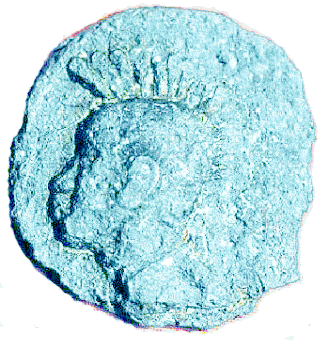|
Chera Coin -
Roman Connection in Tamil Nadu
The Hindu, 26 January 2007
 CHENNAI:
A Chera coin made of silver, with the portrait of a Cheraking
wearing a Roman-type bristled-crown helmet, acquired by R.
Krishnamurthy, has come into focus for its potential significance.
Dr. Krishnamurthy is the Editor of Dinamalar, a Tamil daily. CHENNAI:
A Chera coin made of silver, with the portrait of a Cheraking
wearing a Roman-type bristled-crown helmet, acquired by R.
Krishnamurthy, has come into focus for its potential significance.
Dr. Krishnamurthy is the Editor of Dinamalar, a Tamil daily.
While the portrait is found on the obverse side of the coin, its
reverse shows traces of "bow and arrow," the symbol of the Chera
dynasty. The coin is highly corroded but the portrait is clearly
visible. It has a diameter of 1.6 cm and weighs 1.8 gm.
Dr. Krishnamurthy procured it a year ago from a coin collector named
Veeramani who belongs to Krishnagiri in Dharmapuri district in Tamil
Nadu. Mr. Veeramani was said to have obtained it from a gold-panner
working on the sands of the Amaravathi riverbed in Karur.
The obverse side of the coin has the portrait of a king, facing
left, wearing a Roman-type helmet. With a flat nose and protruding
lips, he has a wide and thick ear lobe but wears no ear-ring. The
person depicted appears to be elderly.
There is no legend above or around the portrait. There are traces of
"bow and arrow," the symbol of the Chera dynasty, on the reverse.
Dr. Krishnamurthy, a numismatist of repute, said: "Probably this
coin is an important discovery. The importance is due to the
portrait, which may represent a Chera king.
Unlike other Chera silver portrait coins, the king's portrait on
this coin faces left."
Earlier, several Sangam Age Chera coins including one with a
portrait and the legend "Mak-kotai" and another with the legend
"Kuttuvan Kotai" had come to light. These were discovered from the
Amaravathi riverbed.
The coin in Dr. Krishnamurthy's possession is more or less similar
to these two, which have a portrait with a legend above it. The
reverse side is blank. The latest coin points to Romans having had
trade contacts with the Chera kings.
Dr. Krishnamurthy said: "There are so many proofs to show that the
Romans had trade contacts with the Tamils, especially with the Chera
country. From the later part of the first century B.C. there was a
big trade contact between Romans and the Chera kings. This [coin]
clearly establishes that the Roman soldiers had landed in the Chera
country to give protection to the Roman traders who had come there
to buy materials. A Chera king with a Roman helmet is important.
This especially has bristles."
Dr. Krishnamurthy added: "Praetorian guards wore helmets with
bristles.It was generally believed that the Satavahanas were the
first indigenous monarchs to issue silver portrait coins. That has
been disprovedby the discovery of Mak-kotai and Kuttuvan-Kotai coins
belonging to the first century A.D. or a little later. But the coin
under consideration may beearlier to the previous portrait coins
already published. This coin maybelong to the first century B.C. and
may be earlier to Mak-kotai andKuttuvan-Kotai coins."
Silver coins issued by Augustus and Tiberius, the Roman emperors,
have over a period of time been discovered in large numbers from the
Coimbatore-Karur tract which formed part of the ancient Chera
country.
|